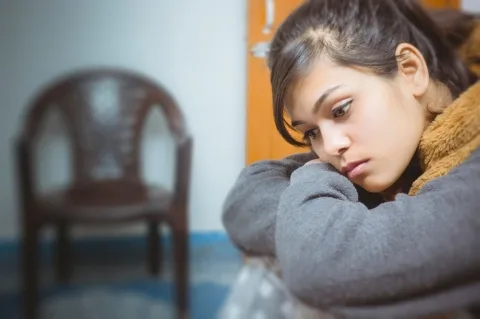
The death of former Miss USA and Emmy-award winning TV star Cheslie Kryst in 2022 cast a shocking spotlight on the increase, among people of color, of suicidal behaviors that can arise from persistent thoughts of harming oneself.
When Kryst, a 30-year-old lawyer with an MBA, died by suicide, researchers who focus on the problem were frequently asked to offer insight into the issue. One traditional view is that suicide in America is principally a “White problem,” fueled, in part, by the fact that most suicide deaths do occur in White people, the largest segment of the US population. However, recent scholarship underscores that among Black and Latinx Americans, suicidal ideation or intent is part of what many experts are calling a mental health crisis in the US. In May 2023, a study published in JAMA documented a fivefold yearly rise in emergency room visits by children and teenagers across all ethnicities as a result of suicide-related symptoms between 2011 and 2020. The National Institutes of Mental Health (NIMH) reported that COVID pandemic helped to fuel the surge.
“The evidence from the CDC [Centers for Disease Control] shows clearly that kids and teens are struggling with mental health in higher numbers,” said Michael Lindsey, dean of the Silver School of Social Work at NYU, whose research focuses on the particular risks facing Black young people.
The mystery that Lindsey and other researchers in social work are trying to unravel is why this is happening and what can be done. To help answer these questions, evidence-based studies have emerged recently from a small but growing number of experts at NYU Silver, with each encouraging the development of culturally specific constructs and interventions to help younger people of color as well as first-generation immigrants.
In adolescents and elementary school children, persistent mild depression, when ignored, can lead to debilitating, major depression later in life. In the worst imaginable situation—a suicide, though this outcome is relatively rare—friends and loved ones are often left with unanswered questions. A child or young adult’s suicidal intentions may wear a smile or hide behind irritability. Symptoms might have been misattributed to a normal phase of personal development, temperament, or, especially in Black and Brown youth, behavioral problems bringing disciplinary measures.
Research emerging in psychology, social work, public health, and other fields suggests that Black, Brown, and first-generation immigrants contend with discrete risks that are different from the experiences of many of their White contemporaries. Religiously informed stigmas against suicide and receiving professional help for mental health struggles are not uncommon in some communities. And there can be heightened worries about burdening loved ones, who may themselves be struggling, financially or psychologically, without access to reliable income or health care.
Additionally, mental health supports and public resources promoting positive social engagement—neighborhood programs in the arts and sciences, say, or after-school classes in music or meditation—can be difficult to find in communities of color, which too often have overcrowded schools, underfunded public libraries, and high concentrations of violence, drug traffic, and other risks.
“Effective suicide interventions exist for White youth,” write NYU Silver professors Marya Gwadz and Ifrah Mahamud Magan and former Silver (and current Boston College School of Social Work) faculty member Carolina Vélez-Grau in a qualitative evaluation published in February 2023. But, they added, citing work by themselves and others, “the evidence of the efficacy for these interventions among ethnocultural minoritized youth is low.”
Titled “The Burden of Not Belonging,” their study included five focus groups with 29 Latinx and Black adolescents, and brought the youths’ own voices into discussions of the precipitating causes of suicidal behaviors and more effective mental health intervention.
The focus groups shed light, in particular, on the relevance of the Interpersonal Theory of Suicide conceived by Florida State University psychologist Thomas Joiner in 2005. This theory identifies “thwarted belongingness” and “perceived burdensomeness” as the main risk factors behind a person’s suicidal thoughts. It is only when both factors are present, Joiner held, that suicidal thoughts can result. And it’s only when a youth endures provocative and painful experiences, such as witnessing acts of violence by others, that they may potentially become numb and build the capability to kill themselves, said Joiner.
But a different, data-driven study published in September 2023 by Vélez-Grau and on which Lindsey and other scholars collaborated posited that feelings of thwarted belongingness (i.e., “I am feeling disconnected from others”), but not perceived burdensomeness (i.e, “I make things worse for people in my life”) are associated with a young person of color turning to thoughts of suicide. The difference may derive from the observation, drawn from national data, as well as the focus groups, that minority youth tend to place great emphasis on their family ties—the locus of comfort, self-esteem, and connectedness. So both risk factors, the study asserted, may need not be present when it comes to young people of color. The study honed in on the highly diverse Latinx population and was published in the journal Suicide and Life-Threatening Behavior.
Lindsey coauthored a May 2022 analysis titled “Black Youth Suicide” that helped improve understanding of the need for effective mental health practices and the development of suicide-prevention programming in schools and at the community level. Published in the Journal of the American Academy of Child and Adolescent Psychiatry, “Black Youth Suicide” noted: “In the United States, suicide is the second leading cause of death in youths 5 to 17 years of age.” It also identified a significant upward trend in Black child and adolescent suicide deaths between 2003 and 2017, particularly among girls. Additionally, it found, children ages 5 to 11 were more likely than older decedents to have experienced family problems or crises at school.

